ANALYSIS AND COMMENTS
GROWTH RATES IN GDP
In seasonally adjusted terms, GDP increased by 1.0% in the December quarter, the highest growth since June quarter 2005 (1.4%). Through the year growth in trend terms was 2.4% (2.8% seasonally adjusted). Following the fall in GDP (in seasonally adjusted volume terms) in December quarter 2000, there have been 24 consecutive quarters of growth. Growth rates in GDP over the past two years have been generally below the average growth rates experienced since the early 1990s.
Percentage changes, Volume measures
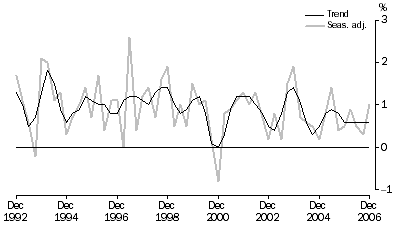
On the expenditure side, the growth (in trend volume terms) over the past four quarters was driven by Household final consumption expenditure (contributing 2.0 percentage points to GDP growth), Public gross fixed capital formation (contributing 0.6 percentage points) and Non-dwelling construction (contributing 0.5 percentage points). Offsetting the growth during the past four quarters was a strong rise in Imports of goods and services (detracting 1.9 percentage points).
On the production side, the strongest industries (in trend volume terms) over the past four quarters have been Finance and insurance (0.6 percentage points), Construction, Property and business services (both contributing 0.5 percentage points to GDP growth), and Mining (0.4 percentage points). Detracting from growth was Agriculture which took 0.6 percentage points from GDP growth over the past four quarters.
Selected Industries Contribution to growth, Dec qtr 05 to Dec qtr 06: Trend
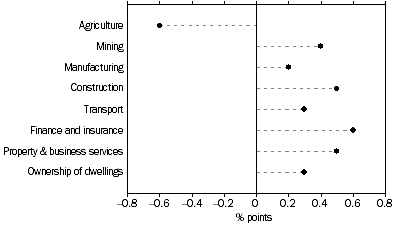
REAL GROSS DOMESTIC INCOME
The real purchasing power of income generated by domestic production can be affected by changes in import and export prices. Real gross domestic income adjusts the chain volume measure of GDP by the Terms of trade. The graph below provides a comparison of quarterly movements in trend GDP (volume measure) and Real gross domestic income. During the December quarter, trend Real gross domestic income increased by 1.0%, compared to the increase in the trend volume measure of GDP of 0.6%, reflecting a 1.7% improvement in the trend Terms of trade. Growth in Real gross domestic income over the past 4 quarters is 3.9% compared to 2.4% for GDP.
Percentage changes: Trend
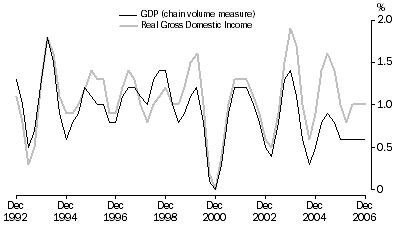
TERMS OF TRADE
The Terms of trade represent the relationship between the prices of exports and imports. An increase (decrease) in the Terms of trade reflects export prices increasing (decreasing) at a faster rate than import prices. The strong growth in the Terms of trade from December quarter 2003 (up 31.6%) reflects growth of over 30% in export prices and relatively flat import price growth over the period. The December quarter 2006 saw a 1.7% increase in trend terms to a record high in the Terms of trade index since September quarter 1959.
Trend, (2004-05 = 100)
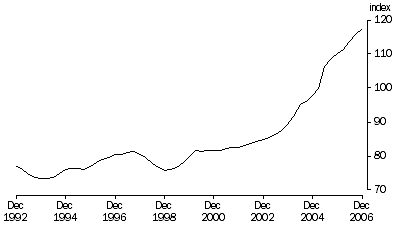
REAL NET NATIONAL DISPOSABLE INCOME
A broader measure of change in national economic well-being is Real net national disposable income. This measure adjusts the volume measure of GDP for the Terms of trade effect, Real net incomes from overseas and Consumption of fixed capital (see Glossary for definitions). The graph below provides a comparison of quarterly movements in trend GDP (volume measure) and Real net national disposable income. During the December quarter, trend Real net national disposable income increased by 0.7%, with growth over the past 4 quarters at 3.1% compared to 2.4% for GDP.
Percentage changes: Trend
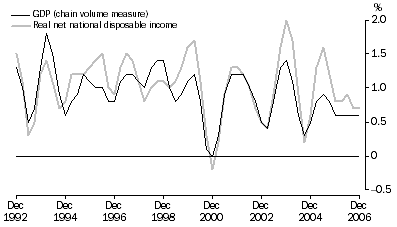
NET EXPORTS CONTRIBUTION TO GROWTH
Net exports represents the difference between exports and imports of goods and services. Net exports detract from GDP growth when the change in the volume of imports is greater than the change in the volume of exports. In the December quarter, Net exports, in trend terms, detracted 0.5 percentage points from GDP growth, the largest detraction since December 2004. In seasonally adjusted terms, Net exports detracted 1.3 percentage points, the largest detraction from GDP growth since September quarter 1997.
Net Exports Contribution to growth, Volume measures
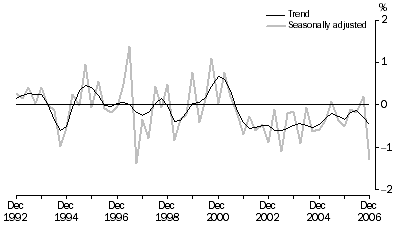
HOUSEHOLD SAVING RATIO
In both trend (-0.8%) and seasonally adjusted (-1.0%) terms the Household saving ratio was negative in December quarter 2006, implying that household consumption was greater than household disposable income.
Household saving cannot be directly measured by the National Accounts. Rather it is calculated as a residual item by deducting Household final consumption expenditure from Household gross disposable income. As the difference between the two aggregates is relatively small, caution should be exercised in interpreting the Household saving ratio in recent years, because major components of household income and expenditure may be subject to significant revisions. The impact of these revisions on the saving ratio can cause changes in the direction of the trend.
Household saving ratio, Current prices
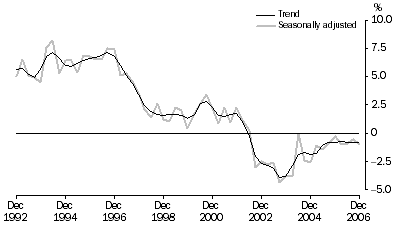
NATIONAL ACCOUNTS LABOUR MARKET INDICATORS
The National Accounts dataset contains a number of labour market related indicators.
Labour costs are the costs incurred by employers in the employment of labour. These costs include wages and salaries, paid leave, superannuation, taxes on employment, training and recruitment costs, and fringe benefits (included in wages and salaries in the national accounts). They are of particular interest as they impact on the competitiveness of organisations, employers' willingness to employ and individuals' willingness to supply labour.
Labour costs are reflected in household income via Compensation of employees and as such have a significant impact on household consumption, investment and saving decisions.
In December quarter 2006, seasonally adjusted Compensation of employees grew by 2.2%, while the seasonally adjusted number of employees recorded in the Labour Force survey grew by 0.5%. Average compensation per employee increased by 1.7%.
Through the year growth in seasonally adjusted average compensation per employee was 4.2% compared to 4.0% growth over the same period in the total hourly rates of pay, excluding bonuses as published in Labour Price Index, Australia (cat. no. 6345.0). It should be noted that the conceptual bases for these two wage measures are different.
In trend terms, Hours worked increased by 0.6% during the December quarter with through the year growth at 2.4%. In the Market sector (see Glossary for definition) Hours worked increased by 0.8% during the December quarter with through the year growth at 2.3%.
In the December quarter, GDP per hour worked (in trend terms) was unchanged. This compares to a fall 0.2% in the September quarter. Market sector GDP per hour worked (in trend terms) increased 0.1% in the December quarter and 0.8% through the year. Estimates of GDP per hour worked are commonly interpreted as changes in labour productivity. However, it should be noted that these measures reflect not only the contribution of labour to changes in production per hour worked, but also the contribution of capital and other factors (such as managerial efficiency, economies of scale, etc.)
The figure below presents quarterly growth rates in trend GDP, employment and hours worked. Growth in both employment and hours worked has slowed over the past two quarters, following on from slowing growth in GDP. The relationship between GDP, employment and hours worked is complex and has attracted a great deal of interest. The ABS has produced a number of pieces of analysis which investigate the relationship in detail. For more information please refer to Leading Indicators of Employment (Feature Article) and the Research Paper: Analysing the Terms of Trade Effect on GDP and Employment in the Presence of Low Real Unit Labour Costs (cat. no. 1351.0.55.014).
Percentage changes, Trend
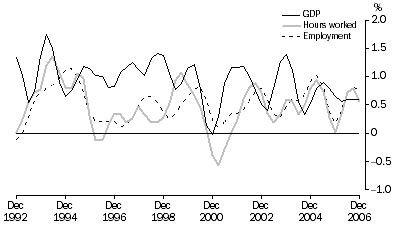
Unit labour costs (ULC) represent a link between productivity and the cost of labour in producing output. A Nominal ULC measures the average cost of labour per unit of output while a Real ULC adjusts the nominal ULC for general inflation. Positive growth in a real ULC indicates that labour cost pressures exist.
In the December quarter 2006, the trend Real ULC decreased by 0.1% while the trend Non-farm Real ULC decreased by 0.8%. The Non-farm measure is generally preferred as it removes some of the fluctuations associated with Agriculture.
CHANGES IN INVENTORIES
Changes in inventories can have a significant impact on the growth in GDP in any particular quarter. A positive change in inventories can be seen as production increasing at a faster rate than consumption but the exact reasons underlying changes in inventories can be far more complex. For example, firms may run up or run down inventories in anticipation of future sales, supply constraints could affect inventories, or firms may under or over estimate sales in a particular period.
The graph below shows GDP growth and the Change in inventories contribution to GDP growth, both in trend terms. Even in trend terms the Change in inventories contribution to GDP growth is quite volatile. Since December quarter 2003, Changes in inventories has only had a positive contribution to trend GDP growth twice - in December quarter 2005 and December quarter 2006 (both 0.1 percentage points).
Inventories and GDP: Trend
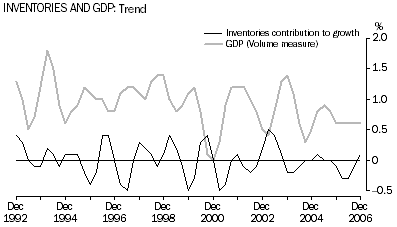
Change in inventories can be disaggregated into a number of industries. The graph below shows the three largest inventory holding industries, Manufacturing, Wholesale and Retail trade. Since September quarter 2005 both Wholesale and Retail trade have exhibited a downwards trend in Changes in inventories, with Wholesale trade showing the most pronounced trend. Over the past two quarters the decline in Manufacturing inventories has slowed.
Change in inventories, Selected industries: Trend
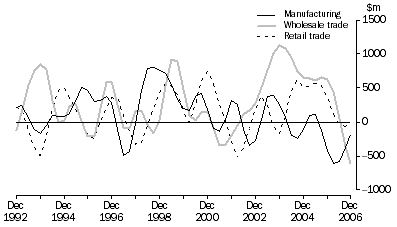
UPDATE - IMPACT OF THE DROUGHT
The ABS has recalculated its projections of the impact of the drought on agricultural production in 2006-07 using the forecasts from the Australian Bureau of Agricultural and Resource Economics (ABARE) publication Australian Commodities of 18 December 2006 and the Australian Crop Report of 20 February 2007.
In annual terms Farm GDP is projected to fall from $26.3b in 2005-06 to $20.5b in 2006-07, a fall of $5.8b or -22.1%. If this were to occur it will make a negative contribution of approximately 0.6% to GDP growth in 2006-07.
The table below presents updated estimates and projections of agricultural production in seasonally adjusted volume terms. It provides published estimates for March, June, September and December 2006 quarters and projections for the next two quarters. Outputs are projected to fall at a faster rate relative to inputs in 2006-07. Outputs are projected to fall by 16.5% in 2006-07, driven by lower production of cereals (-61.7%) and non-cereal crops (-12.1%). Inputs are projected to fall by 9.4% in 2006-07.
Agricultural production, Volume measures(a): Seasonally adjusted |
|  |
 | 2005-06 | 2006-07 |  |
 | Mar | Jun | Sep | Dec | Mar(b) | Jun(b) |  |
 | $m | $m | $m | $m | $m | $m |  |
|  |
| Outputs | 12 054 | 11 600 | 10 617 | 9 695 | 9 865 | 8 827 |  |
| Inputs | 5 266 | 5 134 | 4 896 | 4 613 | 4 599 | 4 389 |  |
| Gross farm product at market price | 6 787 | 6 466 | 5 720 | 5 082 | 5 266 | 4 438 |  |
| Less net taxes on products | 135 | 130 | 119 | 109 | 111 | 99 |  |
| Gross value added at basic prices | 6 652 | 6 336 | 5 601 | 4 973 | 5 156 | 4 339 |  |
| Gross domestic product | 231 684 | 232 838 | 233 615 | 236 054 | na | na |  |
|  |
| na not available |
| (a) Reference year for volume measures is 2004-05. |
| (b) Projections are based on ABARE forecasts. |
The graphs below, in seasonally adjusted volume terms, show the updated projections for the five major categories of agricultural output. It shows that the most significant impact of the current drought will be to cereal and non-cereal crops.
Farm output, Volume measures(a) - Seasonally adjusted
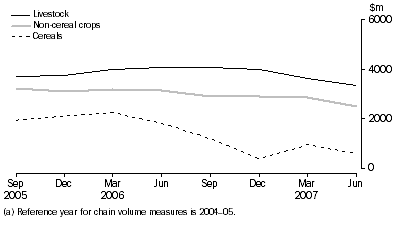 Farm output, Volume measures(a) - Seasonally adjusted
Farm output, Volume measures(a) - Seasonally adjusted
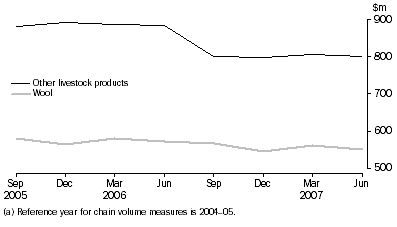
RELIABILITY OF CONTEMPORARY TREND ESTIMATES
Trend estimates are used throughout this publication as an alternative approach to the analysis of movements in time series data. Further details regarding the procedures used to estimate the trend series are described in the Explanatory Notes (paragraphs 13 - 17) and in Information Paper: A Guide to Interpreting Time Series - Monitoring Trends, 2003 (cat. no. 1349.0).
Potential revisions to trend estimates can be indicated by showing the effects of particular changes in seasonally adjusted estimates that might occur in the next quarter. The table below shows the trend estimates for the last ten quarters and the values to which they would be revised if the given movements in seasonally adjusted GDP actually occurred in March quarter 2006. In the absence of any other revisions, seasonally adjusted growth of 0.2% is required in March quarter 2007 to maintain, in March quarter 2007, the trend growth of 0.6% currently estimated for the December quarter 2006.
Percentage change in GDP Chain volume measure |
|  |
 |  |  |  | Trend estimate if seasonally adjusted GDP changes by the following amounts in March qtr 2007 |  |
 |  | Seasonally adjusted GDP as published in table 2 | Trend GDP as published in table 1 | Grows by 1.0% | No change | Falls by 1.0% |  |
|  |
| 2004 |  |  |  |  |  |  |
 | September | 0.5 | 0.3 | 0.3 | 0.3 | 0.3 |  |
 | December | 0.2 | 0.5 | 0.5 | 0.5 | 0.5 |  |
| 2005 |  |  |  |  |  |  |
 | March | 0.8 | 0.8 | 0.8 | 0.8 | 0.8 |  |
 | June | 1.4 | 0.9 | 0.9 | 0.9 | 0.9 |  |
 | September | 0.4 | 0.8 | 0.8 | 0.8 | 0.8 |  |
 | December | 0.5 | 0.6 | 0.6 | 0.6 | 0.6 |  |
| 2006 |  |  |  |  |  |  |
 | March | 0.9 | 0.6 | 0.6 | 0.6 | 0.6 |  |
 | June | 0.5 | 0.6 | 0.6 | 0.7 | 0.4 |  |
 | September | 0.3 | 0.6 | 0.6 | 0.6 | 0.5 |  |
 | December | 1.0 | 0.6 | 0.8 | 0.5 | 0.3 |  |
|  |
 Print Page
Print Page
 Print All
Print All